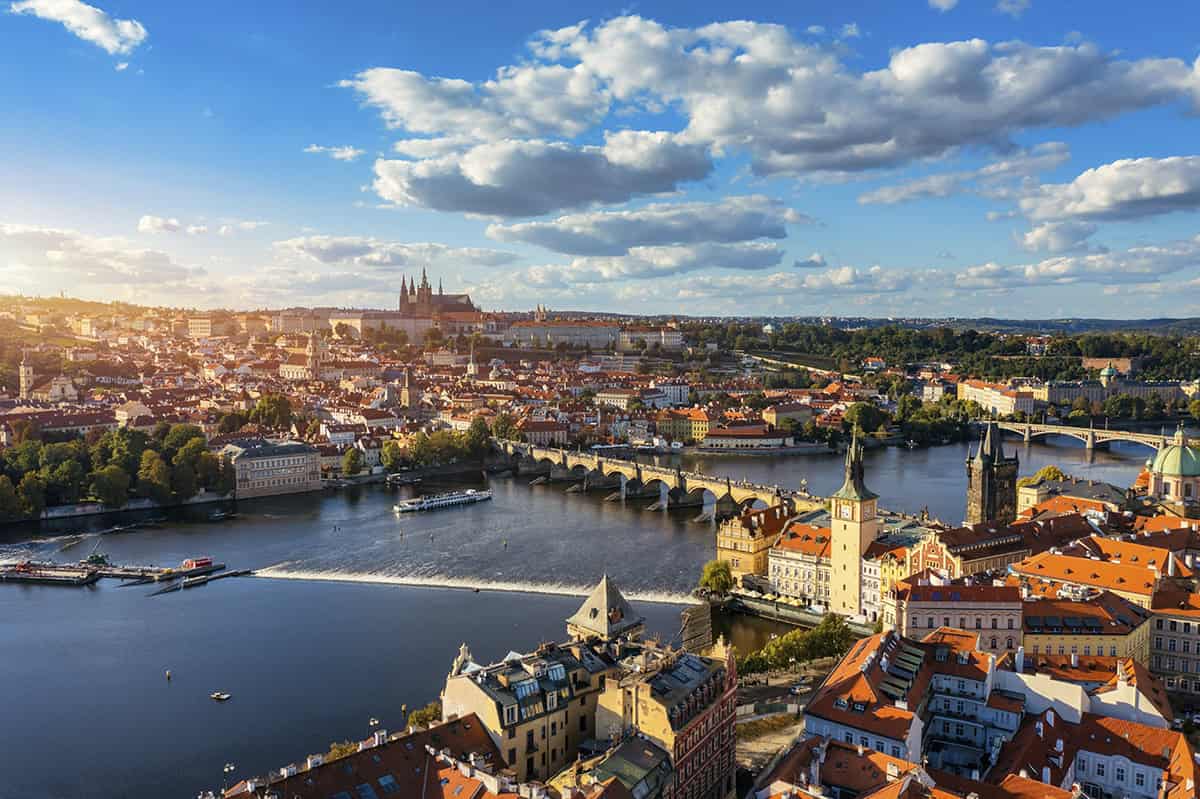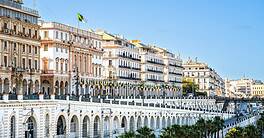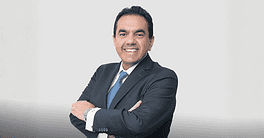Czechia engineers a shift from heavy industry to green energy and high tech as it recovers from last year’s recession.
In the years between the world wars, Czechoslovakia was the economic powerhouse of Central Europe, synonymous with such names as Skoda Autos, Tatra Truck, Jawa Motorcycles, Bata Shoes, and Bohemia Crystal, with the region’s highest living standard.
Since the collapse of the Eastern Bloc in 1989, the Czech Republic, or Czechia—one of the two successor states after Czechoslovakia split in 1992—has rebuilt this reputation for excellence, with the auto industry (now almost 25% of exports), machinery and equipment, and electrical sustaining a modern manufacturing economy. A dynamic services industry led by tourism, business services, and communications has helped create a diversified economy, stabilized by EU membership and close integration into the European and particularly the German supply chain.
Foreign direct investment in Czechia is strong as well, with over 2,100 projects currently underway and stock topping $200 billion: almost double the total of 10 years ago. Despite being outside the eurozone, Czechs are some of Europe’s wealthiest citizens; per capita GDP is just over $30,000—ahead of Spain at $29,600—and expected to rise 24% to $37,000 by 2029, according to Statista.
| VITAL STATISTICS |
|---|
| Location: Central Europe |
| Neighbors: Austria, Slovakia, Poland, Germany |
| Capital City: Prague |
| Population (2021): 10.6 million |
| Official language: Czech |
| GDP per capita (2021): $29,800 |
| GDP size: $290 billion |
| GDP growth: -0.3% (2023); 1.4% expected in 2024, 2.5% in 2025 |
| Inflation (2024): 2% |
| Unemployment rate: 3.7% |
| Currency: koruna. Fully convertible. |
| Investment promotion agency: CzechInvest (www.czechinvest.org) |
| Investment incentives: The government offers a wide range of incentives to investors, particularly in such sectors as manufacturing, manufacturing of strategic products, and business technology. |
| Corruption Perceptions Index (2022): 41 (out of 180 countries) |
| IMD World Competitiveness Ranking: 29 out of 63 global economies (2024) |
| Credit Rating: AA- (Fitch Ratings) |
| Political risk: Since November 2021, the country has been governed by Spolu (Together), a centrist coalition; the prime minister is Petr Fiala and the president (since January 2023) is Petr Pavel, a former general. |
| Security risk: The Czech Republic has good relations with all its neighbors and is a pro-active member of the EU and NATO, supporting mainstream western policies and strategies in favor of Ukraine and sanctions against Russia. |
| FDI: Stock of FDI: $202.7 billion; inflows equal 3.37% of GDP (Figs 2022, IMD World Competitiveness Survey |
| PROS |
|---|
| Location; Czechia lies at the heart of Central Europe with good road, rail, and air links to its neighbors and beyond |
| A diversified economy with a strong manufacturing base |
| Well integrated into western supply chains |
| A dynamic services sector including tourism, business services, and transport. |
| CONS |
|---|
| Labor shortages |
| Rising wages |
For more information on the Czech Republic, click here to read Global Finance’s country report page.
A pro-business, center-right coalition government has taken concrete steps to shift the country toward green energy while extending the capabilities of CEZ, Czechia’s huge nuclear power company, reinforcing investors’ and business owners’ feelings of confidence. CEZ plans to boost nuclear power production as well as other clean energy sources. It follows a strategy called Energy for the Future focused on energy efficiency and new technologies, including renewables.
“There is a well-structured plan to reduce exposure to Russian energy against a backdrop of improving public finances, a loosening monetary policy, and a better economic performance,” says Malgorzata Krzywicka, associate director at Fitch Ratings, which recently raised its AA- rating outlook from negative to stable, Fitch’s highest rating in emerging Europe.
Although the capital city of Prague remains the wealthiest region, investment has spread throughout the country. And the country continues to benefit from EU cash infusions, including from the Cohesion Fund and the Recovery and Resilience Fund, established to aid recovery from the Covid-19 crisis.
After last year’s shallow recession, however, growth is expected to gradually accelerate but remain below potential. Czechia appears to have fallen into the middle-income trap; rising real wages and price increases likely have affected long-term competitiveness, says Krzywicka.
“Labor costs and prices are higher than in other countries in the region,” she notes, “and have led to economic imbalances. Right now, the Czech growth model has its limitations, with a lot of dependence on autos and heavy industry” and too-great reliance on recovery in Germany.
While the three main auto makers—Skoda (Germany), Hyundai (South Korea), and Toyota (Japan)—are shifting to electric car and battery production, the process has been slower than in other countries, including neighboring Hungary: a situation compounded by shortages of qualified labor and Czechia’s higher wage costs.
A recent Fitch study of nearshoring found that the republic lagged behind Romania and Poland on account of those countries’ larger populations and lower wage costs. And while it boasts high scores for corporate governance and transparency—Transparency International ranks it 41 out of 180 countries—it lags in business set-up time and administrative cost.
Moving To Higher-Value Production
Officials seem aware of these issues. The Czech Chamber of Commerce says the move away from heavy industry is key if GDP growth is to exceed the 1% to 2% range. Value-added is one of the lowest in the EU, with the republic ranking 24 out of the 27 member countries.
“If the economy is to continue to converge with Western countries, it will have to move toward higher value-added production,” Chamber of Commerce President Zdeněk Zajíček said last year. “In such a situation, [we could] remain competitive even with relatively more expensive labor.”
But the state must play a role bringing about the shift, he added: “In addition to strategic investments in energy, transport, data, and other infrastructure, investments in science, research, and education all play a crucial role. The state must also motivate companies to be innovative.”
The economy is already shifting focus toward new technologies, including artificial intelligence (AI) and nanotechnologies, medical research (including cancer), and research & development through both foreign direct investment and local start-ups, says Martin Partl, director of UK and Ireland operations at CzechInvest (the Investment and Business Development Agency of the Czech Republic).
“What matters isn’t quantity but quality,” he says. “The Czech Republic has a long tradition of industry working hand in hand with universities and technical institutes, especially in Prague and Brno, with their strong life-sciences departments, and in Liberec, with its focus on nanotechnologies. This, coupled with our central European location and long border with Germany, gives us a unique appeal.”
Optimistic observers say Czechia has the potential to become Central Europe’s Silicon Valley. Last year, a $400 million project was launched to transform Prague’s vast, 100-year-old Strahov Stadium into a new technologies hub, geared to attract cutting-edge investments and startups in such areas as robotics, AI, drones, and medical research and engineering.
ON Semiconductor (onsemi), the US technology and semiconductor maker, announced in June that it will invest some $2 billion over the next several years in its vertically integrated silicon carbide plant near Zlin. It is one of the largest-ever investments in the republic and one of the first investments in advanced semiconductor manufacturing in central Europe; among other things, it is expected to shift the automotive industry toward greener electromobility.
“The expansion would also enhance our production of intelligent power semiconductors, essential to helping ensure the EU [can] significantly reduce carbon emissions and its environmental impact,” says Hassane El-Khoury, president and CEO of onsemi.
While the republic’s infrastructure is advanced by regional standards, work has started on its first high-speed railway, which will allow trains to travel at speeds of up to 320km an hour and eventually connect Prague to Brno and on to Dresden; the project is expected to be completed by 2030.
In the meantime, the Czech economy looks to continue its slow recovery from last year’s decline in GDP. Fitch’s Krzywicka expects export growth to remain subdued due to the sluggish German economy while private consumption ticks up. The benchmark interest rate, currently at 4.5%, is likely to be cut further over the rest of 2024.
“The main goal of the Czech National Bank is price stability,” Krzywicka says.
In the wider economy, however, change is clearly afoot. The present pro-business government is leaving investors and startups in the priority sectors—including AI, green energy, and other new technologies—in no doubt of its support, says CzechInvest’s Partl: “The message is clear: Go out and do your best. Even if you fail, we will be there to catch you and help you start up again.”




